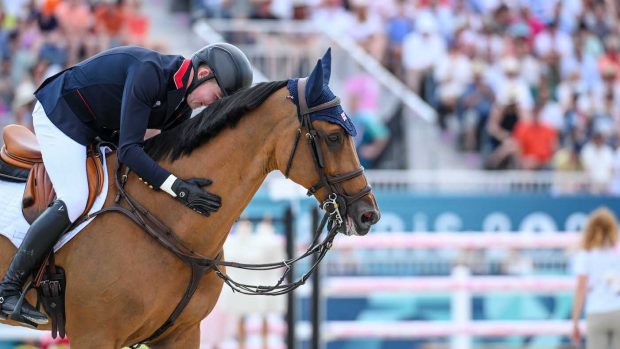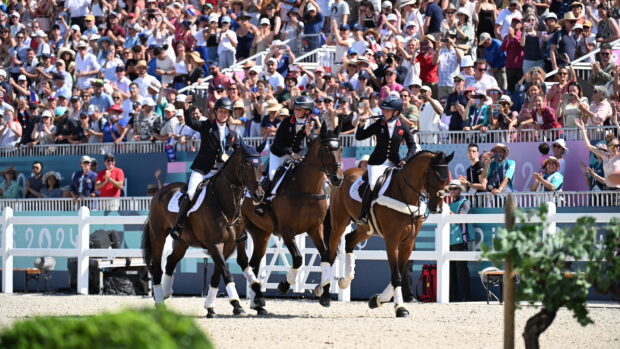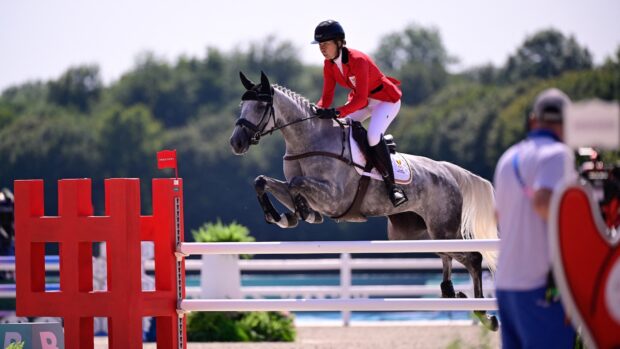French course-designer Pierre le Goupil expects the Paris Olympics cross-country course to favour “brave, positive riding and fast, reactive horses” when the eventers tackle the track on Sunday (28 July).
The optimum time is 9min 2sec – over a minute longer than at the Tokyo Olympics – over a distance of 5,149m. There are 28 numbered fences, with a minimum of 45 jumping efforts.
“It’s more or less flat, and horses at this level should be fit enough, but you never know,” says Pierre, who has used clever siting of the obstacles to slow riders down.
The whole track is stunningly crafted, with each fence having a theme or inspiration. Many are linked to the court of Louis XIV, who lived in the Palace of Versailles, but there are also nods to French literature, boat-building in the Grand Canal, and a spectacular stag’s head with its antlers reaching up into the trees at 7m high. It is – in true French style – fantastically chic, with decorative touches such as real toile de jouy French fabric cushions on a sofa fence and abundant wildflowers.
“Conditions should be perfect”
Pierre is predicting optimum going and conditions, with a little rain forecast in the intervening days. Like much of Europe, deluges in spring meant that the building team had to postponed their installation until the end of May – 10 days behind schedule – as the ground was too wet. But Pierre had worked hard on ensuring the ground would hold up well. For the parts of the course that needed reseeding, you can hear a crunchy sound as you walk, almost sounding like gravel. This is thanks to a volcanic soil he has laid down, which breaks up as it is trampled, drains well and allows for excellent grass growth.
“I discovered it by accident when I was working on a trotting track in Lignieres and used some of the spare volcanic soil they had,” he explains. “When I came back a year later, that ground was better than anywhere else.”
The forecast for cross-country day is around 26ºC, with the last rider scheduled to start around 2.30pm. Pierre expects horses to cope well with a typical French summer’s day.
“More than half the course is in the shade of the trees, and the Grand Canal brings down the heat as well,” he says. “Conditions should be perfect.”
Paris Olympics cross-country course: keeping the flow
The course has a flowing feel to it, with no sharp turn-backs, and long galloping stretches.
Pierre says: “When I first heard about the cross country being at Versailles, I thought, ‘It’s going to be flat. Straight lines, sharp turns, nothing to play with’, and it’s totally different. There’s a lot of things to play with.”
That said, there are several spots where he has put a so-called let-up fence on a bending line, or added some decoration in between fences, to slow riders down without making the horses uncomfortable.
Equally, the long routes at fences are circuitous so in many cases will add plenty of time, but won’t put pressure on tiring horses by needing them to twist and double back on themselves.
Creating the course
Pierre was appointed as Paris Olympics cross-country course-designer in 2022 and has visited the Versailles venue some 60 times over the past two years, and spent “six or seven weeks” of the past two months on site.
Versailles is a virgin eventing site, although it has hosted a showjumping competition in the past. Two of the water fences have been specially created, while the first water is a renovation of an existing fountain site in a former exotic menagerie. After the event is over, all the groundworks will be restored to their original state.
Pierre paid particular tribute to the course-builder Christian Aschard, who will retire after this event, and all the craftsmen and artists who have contributed to this spectacular track.
“I’m the lucky one who gets to design the track, but the designers are only as good as their builders and it’s the builders who don’t enough credit,” says Pierre. “I’ve relied on a high level of skill.”
And that’s exactly what the riders will need, both in themselves and their horses, to tackle the challenge he has set.
- To stay up to date with all the breaking news throughout the Olympic Games, Royal International Horse Show and more, subscribe to the Horse & Hound website

Course walking and arena familiarisation: photos of the British Olympic eventing team’s day at Versailles

It’s time! First look at every fence on Paris Olympic cross-country course in Versailles

Olympic debutante called up as top nation make last-minute change to Paris eventing team

H&H Olympic reporter’s blog: how security scuppered a VIP and why the Olympics feels like Christmas

Subscribe to Horse & Hound magazine today – and enjoy unlimited website access all year round




